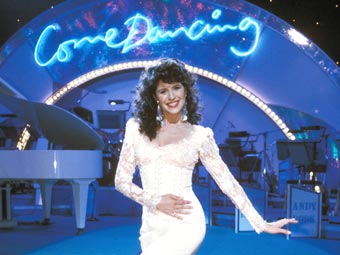Come Dancing
Contents |
Host
MacDonald Hobley (original host)
Other hosts/co-hosts included: Michael Aspel, Noel Edmonds, Don Moss, Pete Murray, Keith Fordyce (some or all of these may have hosted regional heats only)
Sylvia Peters (1954, 58-?)
Brian Johnston (late 50s/early 60s)
Peter West (1957-72)
Judith Chalmers (1961-5)
Terry Wogan (1973-79)
Peter Marshall (1980-3)
David Jacobs (1984-6)
Angela Rippon (1988-91)
Rosemarie Ford (1992-8)
Co-hosts
Commentators:
Peter Dimmock (1950s)
Barry Haynes (?-1978)
Ray Moore (1979)
Bruce Hammal (1980-4)
Charles Nove (1985-98)
Broadcast
BBC1, 29 September 1949- 11 September 1995 (one series each year except 1982 and 1987, game show format introduced 1953)
International Come Dancing specials: 11 & 18 September 1996 and 2 January 1998 (3 episodes)
"50th anniversary" special: 29 December 1998
Synopsis
Not merely the longest-running gameshow in the land, but at one time the longest running British TV show of any kind whatsoever. Launched in 1949 as a sort of companion piece to the already popular Television Dancing Club, the show originally had an educational outlook, with leading dancers of the day instructing viewers in how to do the various dances. After a while the format was re-jigged, and in 1953 the familiar regional dance-offs and national final were introduced, with separate categories for each dance.
Series creator Eric Morley was the original Master of Ceremonies, assisted, and then succeeded, by a seemingly endless list of presenters. Just about everyone had a go at it down the years, from the barely-remembered (disc jockey Don Moss) to the fondly recalled (the inevitable Terry Wogan) and the frankly miscast (Noel Edmonds fronting a ballroom dancing competition? It happened.)
True enough, the show did seem a little anachronistic for much of its existence, but it did try to move with the times, with new styles like rock 'n' roll and disco added to the existing categories (we don't think there was ever a category for body popping, though). The glamour was always very much to the forefront, with the contestants' dresses always described in loving detail - including those sequins, which were invariably "sewn on by hand" (and how else would you attach them? Double-sided sticky tape?)
In the end, Come Dancing became one of those shows, like One Man and His Dog, that were reassuringly always there, yet watched by smaller and smaller audiences. After years of being shunted around in the schedules, the axe finally fell in the mid-1990s.
Inventor
Eric Morley
Trivia
Strange but true: for years and years, it was believed that Come Dancing had started in 1950, rather than 1949. The Guinness Book Of Records stated as much for over twenty editions. It was only when the BBC's 70th anniversary celebrations came around in 1992 that someone thought to check, and found that the previously quoted date was a year out. Oddly, the BBC's own Strictly Come Dancing Story documentary put a date of 1948 on it, for which we can find no evidence. They probably conflated it with the aforementioned Television Dancing Club which did indeed start in 1948 but continued its own separate existence until the mid-60s.
Web links
Pictures
To be completed


